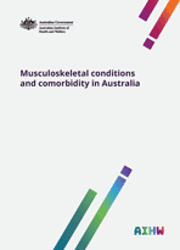Summary
Musculoskeletal conditions comprise more than 150 different conditions of the bones, muscles, ligaments and connective tissues, such as forms of arthritis, osteoporosis and back pain and problems. These conditions have a substantial impact on individuals—through illness, pain and disability—and the community, through health system expenditure and other economic costs, and population disease burden. Comorbidity refers to the occurrence of 2 or more diseases in a person at one time.
This report examines the prevalence of comorbid chronic conditions among people with musculoskeletal conditions using data from the National Health Survey 2014–15 and the National Hospital Morbidity Database 2016–17.
Musculoskeletal conditions are common in Australia
In 2014–15, 30% of Australians had at least 1 musculoskeletal condition. The prevalence generally increased with age, from 1.0% among people aged 0–14 to 72% among people aged 75–84.
The most common musculoskeletal conditions were:
- Back pain and problems (16.2% of the population)
- Osteoarthritis (9.0%)
- Other forms of arthritis (5.3%).
Most people with a musculoskeletal condition had at least 1 other chronic condition
Almost 4 in 5 (79%) people with arthritis and 2 in 3 (65%) people with back pain and problems had at least 1 other chronic condition.
Among people with arthritis, the most common comorbid conditions were:
- Cardiovascular disease (48%)
- Back pain and problems (33%)
- Mental health problems (27%).
Among people with back pain and problems, the most common comorbid conditions were:
- Arthritis (31%)
- Cardiovascular disease (31%)
- Mental health problems (30%).
More than half (54%) the hospitalisations for musculoskeletal conditions involved at least 1 other chronic condition
In 2016–17, there were 536,804 hospitalisations with a musculoskeletal condition as the principal diagnosis. Of these hospitalisations, 41% had 1 additional chronic condition, 9.0% had 2 and 3.4% had 3 or more. Common comorbidities included diabetes, colitis and nerve damage in the limbs.
Musculoskeletal hospitalisations involving comorbid chronic conditions were more likely to involve rehabilitation care and be a same day separation than those that did not involve comorbidities. However, this varied depending on the musculoskeletal condition.
1. Introduction
- What are musculoskeletal conditions?
- What is comorbidity?
- Background
- Prevalence
- Treatment and health outcomes
- Disease burden and health-care costs
- Structure of this report
2. Comorbidity in the community
- What data are available to report on comorbidity in the community?
- National Health Survey
- Australian Burden of Disease Study
- What do the data tell us?
- Prevalence of musculoskeletal conditions
- Age and prevalence of musculoskeletal conditions
- Burden of disease
- Number of comorbid conditions
- Age and comorbidity
- Types of comorbid chronic conditions
- Type of comorbidity and sex
3. Comorbidity in hospital care
- What data are available to report comorbidity in admitted patient care?
- National Hospital Morbidity Database
- Chronic condition grouping
- What do the data tell us?
- Number of comorbid chronic conditions
- Types of comorbid chronic conditions
- Age and comorbidity
- Treatment type
- Length of stay
- Hospitalisations with a musculoskeletal condition as an additional diagnosis
4. Data gaps and limitations
- Scope and coverage
- Classification schemes
- Completeness
- Future work
Appendix A: Musculoskeletal condition groups used in NHMD analysis
End matter: Acknowledgments; Abbreviations; References; List of tables; List of figures; List of boxes



